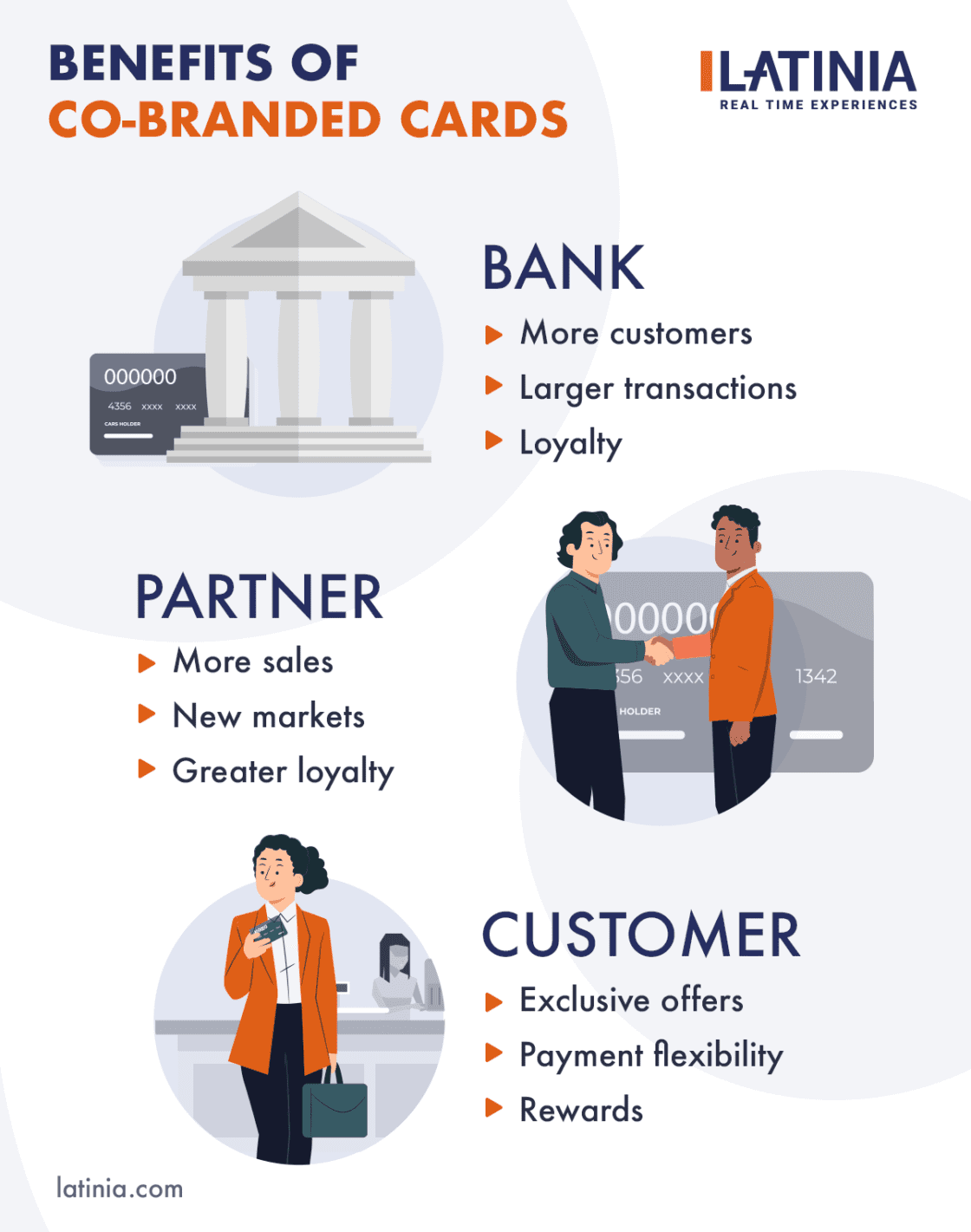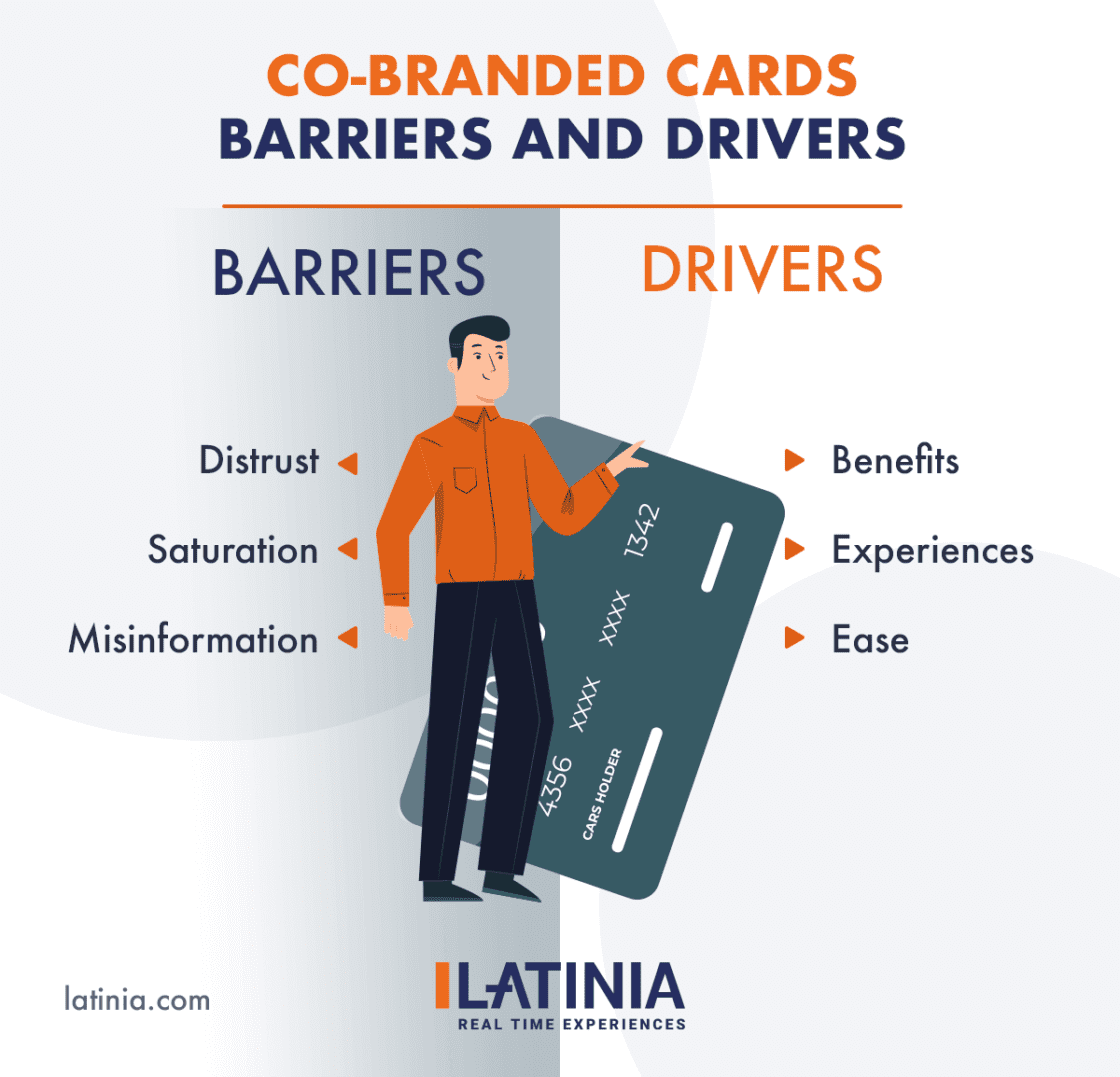
In the competitive banking world, co-branded cards have emerged as a strategic tool to attract and retain customers and strengthen alliances with brands from various sectors. These cards, which combine the identity and benefits of a bank with those of a partnered brand, offer not only financial advantages but also unique loyalty opportunities.
From the frequent traveler who accumulates miles with every purchase to the coffee lover who gets discounts at their favorite café, co-branded cards have resonated with consumers’ specific desires and needs. However, like any other financial product, their success isn’t guaranteed simply by existing. It’s essential to have a solid strategy tailored to current market trends.
Moreover, in an age where immediacy and personalization are paramount, real-time tools have become key allies in driving the acquisition and use of these cards. This is where technological innovation and market strategy converge to create unique and highly effective experiences.
In this article, we will break down the essential elements of a successful co-branded card marketing strategy, paying special attention to how real-time tools, like Latinia NBA, can maximize their potential.
Promotion of Co-branded Card Acquisition
The acquisition of co-branded cards in a saturated financial market presents a challenge. Not only is a product that resonates with the audience necessary, but also effective promotion strategies that adapt to the current media reality.
Traditional Strategies and Their Limited Impact
Over time, co-branded cards have been promoted through various channels, both offline and online:
- Advertising in traditional media: Includes television, radio, and print.
- Point of sale materials: Both in bank branches, stores, and other establishments associated with the allied brand.
- Events and launches: Aimed at presenting the card to a broad audience.
- Direct mail: Sending personalized information and offers to potential customers.
- Ads on digital platforms: Paid advertising on social networks, Google Ads, and banners on relevant websites.
- Newsletters: Used to inform a subscriber base about the benefits and promotions of the card.
- Marketing automation: Segmented email campaigns, remarketing, and other techniques that seek to capture the user at different conversion funnel stages.
Although these strategies have proven effective in the past, advertising saturation in the digital environment and the wear of traditional channels may limit their current impact.
The Power of Real-Time Analysis and Decision Making: Latinia NBA
In contrast to traditional strategies, Latinia NBA’s real-time analysis and decision solutions offer a promising outlook.
- Real-time analysis: Hyper segmentation occurs in real time by analysing business rules in 0,04 seconds.
- Personalized offers: Use infinite variables to get closer to your customer, specifically select who, what, where and when.
- Relevance: Make the difference, it’s not the same to offer a product when you are watching tv than when you are at the exact moment where your product is relevant.
In the following video, you can see some practical examples of using Latinia NBA, including financial product promotions or co-branded credit cards.
These real-time tools revolutionize how to promote co-branded cards, allowing banking institutions to establish more effective connections and increase acquisition rates.
Boosting the Frequent Use of Co-branded Cards
Once customers have acquired a co-branded card, the next challenge is to encourage its regular use. In this regard, real-time interactions play an essential role not only in keeping the customer informed but also in showing them the tangible and real value of the card in their daily life.
Identifying Key Moments in Customer Behavior
Not all moments of interaction with the bank are equally opportune to engage with the customer. Therefore, it’s crucial to:
- Monitor transactions: Identify when a customer makes a purchase where they could have benefited from the co-branded card but didn’t use it.
- Periodic behaviors: For example, if a customer consistently buys their morning coffee, it might be the perfect moment to remind them of the benefits they would get if they used their co-branded card associated with a coffee shop chain.
- Large purchases: Significant transactions, such as booking a trip, can be the ideal moment to highlight exclusive discounts or benefits linked to the card.
Using Latinia NBA to Inform Immediate Benefits and Relevant Promotions
This is where real-time analysis and decision-making tools, like Latinia NBA, stand out:
- Personalization: Instead of offering generic promotions, Latinia NBA can identify which offer would be most relevant for a customer at a given moment.
- Urgency: For instance, a client browsing an affiliated store’s website could receive a real-time message informing them of an exclusive discount if they pay with their co-branded card in the next few hours.
- Adaptability: Customer circumstances change, and Latinia NBA adjusts to them, offering promotions and benefits in line with their current consumption patterns.
Positive Incentive: Real-time Reporting on Generated Benefits
One of the most effective ways to foster a behavior is through positive reinforcement:
- Instant notifications: Every time a customer uses their co-branded card and obtains a benefit (discount, points, etc.), receiving an immediate notification reinforces the perceived value of the card.
- Benefits summary: Sending a detailed summary periodically of all the benefits and savings accumulated from using the card can motivate continued use.
- Testimonials and success stories: Showing examples of other customers maximizing their benefits can be a powerful driver for the customer to do the same.
Key Elements for a Successful Strategy
Co-branded cards have proven to be a powerful tool in the financial arena, but their success is not automatic. Detailed planning and the consideration of various factors are required for them to truly be attractive and valuable to both banking institutions and customers. Here, we detail the fundamental elements that every co-branded card strategy should consider:
1. Selecting the Right Partner
Choosing a business partner for a co-branded card can mean the difference between success and failure. It’s not just about finding a popular brand or one with a significant market presence but about identifying one that shares values, target audiences, and a long-term vision with the bank. Some points to consider are:
- Alignment of Objectives: Both parties must be clear about what they seek from this alliance.
- Complementarity: Look for partners that offer services or products that complement the bank’s offerings.
- Reputation: The brand’s track record and market perception are crucial.
2. Deep Understanding of the Target Audience
Thoroughly understanding the target audience is vital. Not all co-branded cards are for every customer. Some key questions to answer are:
- Who are they? Age, gender, geographical location, consumption habits, etc.
- What do they value? Are they looking for discounts, exclusive experiences, easy financing?
- How do they buy? Do they prefer online shopping, in-store purchases, or a combination of both?
This understanding will allow for the design of a card that truly meets the needs and desires of potential customers.
3. Clear Definition of Mutual Benefits
Both the bank and the allied brand must benefit from the partnership, and those benefits should be clear from the start. Some considerations include:
- For the bank: Increased customer acquisition, higher transactions, customer loyalty, and more.
- For the partner: Increased sales, access to new market segments, greater customer loyalty, among other benefits.
- For the customer: Exclusive offers, payment conveniences, loyalty rewards, among other incentives.

4. Effective Promotion Plan
It’s not enough to have a well-structured co-branded card; it’s essential to have a robust promotion plan to get it into the hands of the target audience and realize its full potential.
From choosing the communication channels to defining the key messages, each step of the promotion plan must be carefully thought out to maximize the card’s penetration and adoption.
In a subsequent section, we’ll delve deeper into the importance and components of an effective promotion plan.
The Current Market Dynamics
The financial and commercial landscape has undergone notable changes in the past decade. Driven by technology, globalization, and shifts in consumer behavior, these changes have redefined how co-branded cards are perceived and utilized. To design an effective strategy, understanding the current market dynamics is crucial.
Profile of the Co-branded Card Consumer
Today’s consumer is more informed, demanding, and aware of their financial decisions than ever before. Some prevailing characteristics include:
- Digital Connectivity: Modern consumers are almost always connected, using multiple devices and platforms. They expect intuitive and efficient digital solutions.
- Pursuit of Personalization: The value of tailored offers and rewards is highly cherished. Consumers want to feel that brands genuinely understand their individual needs and desires.
- Social Responsibility and Awareness: There’s a growing interest in partnering with brands with a positive societal and environmental impact.
- Decreased Brand Loyalty: While rewards and benefits can lure consumers, their loyalty is fickler. They are willing to switch brands if they find more appealing offers or feel they aren’t getting the expected value.
Barriers and Drivers for Acquisition and Use
When discussing the adoption and usage of co-branded cards, it’s essential to consider the barriers that might deter consumers and the motivations that drive them to acquire and use them.
Barriers:
- Mistrust: In a world where security breaches frequently make headlines, some consumers may hesitate to share more financial information.
- Overwhelm: The plethora of available options might make consumers feel it’s challenging to distinguish one co-branded card from another.
- Limited Understanding: Not all consumers fully comprehend the benefits or the reward structures, which could deter their use.
Drivers:
- Tangible Benefits: Discounts, loyalty points, and rewards are clear drivers for adoption and regular use.
- Exclusive Experiences: Access to events, special promotions, or preferential deals can be powerful incentives.
- Ease and Convenience: A user-friendly card with an intuitive app and quality customer service access can be a strong motivator.

Conclusion
In the digital age, customer expectations are constantly evolving, demanding swift and personalized responses. Beyond mere payment tools, co-branded cards have become bridges of relationship between brands and consumers, reinforcing loyalties and offering mutual benefits.
The revolution of real-time banking interactions has changed the game. These interactions, characterized by their immediacy and relevance, enhance a customer experience that is both more seamless and meaningful.
Lastly, tools like Latinia NBA emerged as facilitators and catalysts for this revolution. For those entities looking to stand out in the marketing and promotion of co-branded cards, adapting to these new dynamics isn’t an option but a mandate.
If you want to enhance the promotion and use of your bank’s co-branded cards using real-time analysis tools, contact us, and an expert will address all your queries with no obligation and advise you on the best solution for your specific case.
Categories: Marketing & Sales
